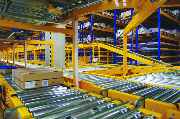 The use of 24V DC technology in continuous conveyor systems has become increasingly popular in recent years and Interroll has been acknowledged as a pioneer in the development and manufacturer of 24 volt RollerDrives.
The use of 24V DC technology in continuous conveyor systems has become increasingly popular in recent years and Interroll has been acknowledged as a pioneer in the development and manufacturer of 24 volt RollerDrives.
In a recent in-depth comparison of 24-volt drive and 400-volt drive technology for roller conveyor systems the findings were very impressive and clearly illustrated the advantages of the energy efficient alternative drive solution.
The results of a scientific study that the Institute for Conveying Technology and Logistics (IFL) at the Karlsruhe Institute of Technology (KIT) conducted under the supervision of Prof. Dr.Ing. Kai Furmans clearly illustrate the advantages that 24 volt solutions offer compared to 400 volt drive technology. For example, transporting cargo that weighs 50 kg with systems that use 24 volt drive technology is about 30 percent more efficient in intermittent operation and even 50 percent more energy efficient during accumulation than systems that employ 400 volt drive technology.
“This white paper provides all of the information needed in order to answer the question of which drive technology, 24 volt or 400 volt, should be used and in which cases,” Prof. Dr.Ing. Kai Furmans from the Karlsruhe Institute of Technology (KIT) explains.
The systems driven by Interroll RollerDrives do not have a central drive station. The drives are located inside each of the individual conveyor zones. This means the control systems can switch the conveyor zones on and off as necessary, completely independently of one another. In other words, movement only takes place in the entire conveyor if goods need to be transported with zero pressure.
In contrast to this, conventional systems are driven by 400 volt geared motors that normally run around the clock, regardless of how much cargo actually needs to be transported.
 A comparative layout was developed at the Institute for Conveying Technology and Logistics in order to learn more about the advantages and disadvantages of using the various drive technologies. This makes it possible to observe the amount of energy needed to transport something during permanent operation, intermittent operation and accumulation. Besides focusing on the amount of energy needed, the evaluation also included other criteria, for instance costs and system performance, but also its flexibility. Interroll assisted the Karlsruhe Institute with conducting this study.
A comparative layout was developed at the Institute for Conveying Technology and Logistics in order to learn more about the advantages and disadvantages of using the various drive technologies. This makes it possible to observe the amount of energy needed to transport something during permanent operation, intermittent operation and accumulation. Besides focusing on the amount of energy needed, the evaluation also included other criteria, for instance costs and system performance, but also its flexibility. Interroll assisted the Karlsruhe Institute with conducting this study.
“Around five times the energy that permanent operation required can be saved by using 24 volt technology. The initial purchase costs can also be reduced quite significantly by using 24 volt technology in both the accumulating conveyor modules and alternative conveyor modules,” Dr. Ralf Garlichs, Executive Vice President Products & Technology at Interroll Group, adds.
Interroll has already retrofitted many systems all over the world by installing its 24 volt drive technology and thus achieved rapid return on investment (ROI) for its end customers.
The complete KIT Study entitled “24 volt drive technology in constant conveying technology,” but there is also an abridged version that can be downloaded from Interroll’s website www.interroll.com
View the study here: http://www.interroll.com/media/editorial_media/interroll_group/downloads/whitepapers/studie2013/short_version/IR1302rz_Kurzversion-E.pdf
